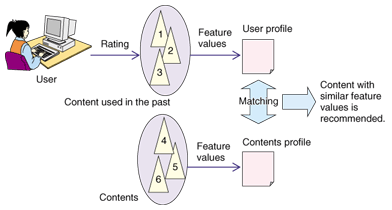Go deep into the process, there are three steps of the recommendation process.
- Content analyzer: the main responsibility of the process is to represent the content of items. it can extract the information or specific features from the item by feature extraction techniques.
- Profile learner: this process will collect data representative of the users preferences and try to generalize the data, then construct the user profile.
- Filtering components: this process will try to match the features of the user profile with the features of the items. And then, the system will recommend items that fit for the user.
it tell you how the system processes the information source and user profiles, so that they can recommend items based on the process.
So, compared to collaborative filtering, there are some advantages and drawbacks of content-based filtering that we should understand.
Advantages
- User independence: collaborative filtering needs other users' rating to find the similarity between the users and then give the suggestion. Instead, content-based method only have to analyze the items and user profile for recommendation.
- Transparency: collaborative method gives you the recommendation because some unknown users have the same taste like you, but content-based method can tell you they recommend you the items based on what features.
- No cold start: opposite to collaborative filtering, new items can be suggested before being rated by a substantial number of users.
- Limited content analysis: if the content does not contain enough information to discriminate the items precisely, the recommendation will be not precisely at the end.
- Over-specialization: content-based method provides a limit degree of novelty, since it has to match up the features of profile and items. A totally perfect content-based filtering may suggest nothing "surprised."
- New user: when there's not enough information to build a solid profile for a user, the recommendation could not be provided correctly.


Good Post. I like your blog. Thanks for Sharing.....
ReplyDeleteMachine Learning institute in Noida
We make it easier for businesses to achieve their KPI’s with personalized recommendations. We deliver highly personal, automated, and contextual insights to improve your customers’ experience and business results.https://divedeep.ai/recommendation-systems-services-and-solutions
ReplyDeleteHy I am francoselectric
ReplyDeleteWe offer a variety of electrical services for both residential and commercial properties, including upgrades, repairs, replacements, and installations.
Electrical Safety and Maintenance Inspections
Electrical panel upgrades
Recessed lighting
Electrical troubleshooting
Dedicated circuits
Wiring
Electrical Surge Protection
Attic and bath exhaust fans
Ceiling fan installation
Fixture repair and replacement
Outdoor/landscape lighting
Hot tub and appliance wiring
Dedicated Circuits and sub panels
Dimmer and light fixture installation
Breaker replacements